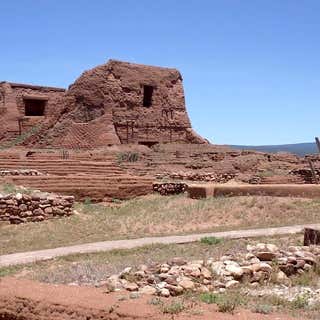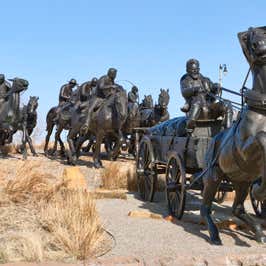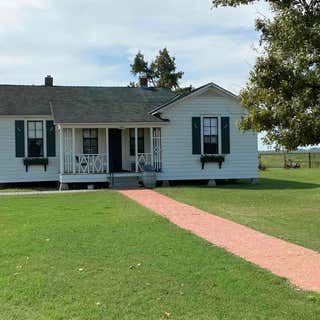A nice stop to stretch your legs and enjoy the beauty all around. This mountain pass has provided safe passage through the Sangre de Cristo Mountains for thousands of years. The introductory film inside the E.E. Fogelson Visitor Center is a must and will explain what you are seeing. The academy award winning actress, Greer Garson, along with her husband, Buddy Fogelson, owned a 13,000-acre ranch in this remote area near Santa Fe. In 1990, after the death of her husband in 1987, Greer arranged for the sale of her portion of the ranch to The Conservation Fund, which donated the land to the National Park Service to become part of Pecos National Historical Park.
Pictures can’t begin to show the beauty and detail of these wonderful bronze sculptures. This important time in Oklahoma’s history is frozen in motion forever. The faces show the emotion and determination of men and hardy women who are racing to claim new homesteads. I stood and studied each of the heroic figures and could picture myself among them; what it must have felt like to be part of the adrenaline-fueled crowd. Fifty thousand strong, riding horseback or wagon, from all walks of life, reaching for a chance to own a 140-acre plot of land.
Dyess, Arkansas was established in 1934 as a small farming town located in the rich Arkansas Delta. Initially, the town was formed as a “colony” to help sharecroppers and struggling farmers regain their footing during the Great Depression. In 1935 the Cash family, who resided in Kingsland, Arkansas, received 20 acres of land and a five-room house as part of Roosevelt’s resettling program.
Dyess became home to the 3-year-old Johnny, known as J.R. to locals and family. The young J.R. worked in the fields alongside his parents and six siblings. Music was always an integral part of everyday life in the Cash family. It was here that J.R. Cash got much of his inspiration for many of his early songs, like “Five Feet High and Rising.” Dyess was also the place where Jack Cash, the older brother of Johnny, died and is buried at the Bassett Cemetery on Highway 61, a short drive south of the town.
The day was Friday, May 12, 1944, when young J.R. begged his older brother to, “Please quit working and come fishing with me.” Jack answered, “No, I’ve got to do this because we need the $3.00. You go ahead and I’ll meet you later.” Jack was working inside the high school agricultural shop, where he was cutting oak trees into fence posts. J.R. left his brother and went fishing. While using the table saw, it jammed. 15-year old Jack leaned over to fix the problem and his clothes got caught in the saw, cutting into his midsection. Jack didn’t live to see his sixteenth birthday, dying one week later. At 12 years of age, the would-be country music legend helped dig his brother’s grave, according to his sister, Joanne. “At the service, his clothes were dirty from the effort, and he wore no shoes since his foot was swollen from stepping on a nail.” After Jack’s death, J.R. lost his child-like, carefree attitude towards life, becoming melancholy and withdrawn.
Johnny Cash lived in Dyess with his family until after high school graduation. He worked for a time at a GM assembly plant in Pontiac, Michigan before joining the Air Force in 1950. His father, Ray Cash, was one of the few in the Dyess Colony who successfully converted his farmstead to agricultural production and paid back the government for his home and land, allowing him to own it outright.




